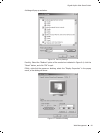
19
Gigabit Uplink Web Smart Switch
The ping function is to test the connectedness of the link between the switch and
destination.
VLANs are logical subgroups with a Local Area Network (LAN) that combine user
stations and network devices into a single unit, regardless of the physical LAN segment
to which they are attached. VLANs allow network traffic to flow more efficiently within
subgroups.
VLANs use software to reduce the amount of time it takes for network changes,
additions, and moves to be implemented.
VLANs can be created per unit, per device, or through any other logical connection
combination, since they are software-based and not defined by physical attributes.
VLANs function at Layer 2. Since VLANs isolate traffic within the VLAN, a Layer 3 router
working at a protocol level is required to allow traffic flow between VLANs. Layer
3 routers identify segments and coordinate with VLANs. VLANs are Broadcast and
Multicast domains. Broadcast and Multicast traffic is transmitted only in the VLAN in
which the traffic is generated.
There are 3 types of VLAN mode supporting in the switch:
1) Port VLAN
VLANs are divided based on ports.
2) IEEE802.1Q Tag VLAN
The IEEE802.1Q protocol defines a new format of the frame. It adds a tag header in
the original Ethernet frame, as follows:
IEEE802.1Q frameFigure 5-1
Fuction Description


















